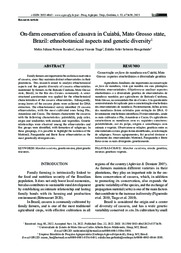On-farm conservation of cassava in Cuiabá, Mato Grosso state, Brazil: ethnobotanical aspects and genetic diversity.
On-farm conservation of cassava in Cuiabá, Mato Grosso state, Brazil: ethnobotanical aspects and genetic diversity.
Author(s): RONDON, M. J. P.; TIAGO, A. V.; HOOGERHEIDE, E. S. S.
Summary: Abstract: Family farmers are important in the on-farm conservation of cassava, since they maintain distinct ethnovarieties in their plantations. This research aimed to analyze ethnobotanical aspects and the genetic diversity of cassava ethnovarieties maintained by farmers in the Baixada Cuiabana, Mato Grosso state, Brazil, in the Rio dos Couros community. A semi structured questionnaire was applied for the ethnobotanical characterization of the cassava ethnovarieties. Subsequently, young leaves of the cassava plants were collected for DNA extraction. The ethnobotanical survey identified 29 cassava ethnovarieties, with the most cultivated ones being Pão, Amarelona and Cacau. The farmers characterize the cassavas with the following characteristics: palatability, pulp color, origin and similarities with animals and vegetables. Genetic relationships were observed among the ethnovarieties and five groups were identified, with formation of subgroups. In these groupings, it is possible to highlight the isolation of the Matrinxã, Paraguainha and Broto Roxo ethnovarieties as the most genetically divergent ones. | Resumo: Agricultores familiares são importantes na conservação on farm de mandioca, visto que mantêm em suas plantações distintas etnovariedades. Objetivou-se analisar aspectos etnobotânicos e a diversidade genética de etnovariedades de mandioca mantidas por agricultores da Baixada Cuiabana, Mato Grosso, na comunidade Rio dos Couros. Um questionário semiestruturado foi aplicado para a caracterização etnobotânica das etnovariedades de mandioca. Posteriormente, folhas jovens das mandiocas foram coletadas para extração de DNA. O levantamento etnobotânico identificou 29 etnovariedades, sendo as mais cultivadas a Pão, Amarelona e Cacau. Os agricultores caracterizam as mandiocas com os seguintes caracteres: palatabilidade, cor da polpa, origem e semelhanças com animais e vegetais. Observaram-se relações genéticas entre as etnovariedades e cinco grupos foram identificados, com formação de subgrupos. Nesses agrupamentos, foi possível destacar o isolamento das etnovariedades Matrinxã, Paraguainha e Broto Roxo como as mais divergentes geneticamente.
Publication year: 2023
Types of publication: Journal article
Observation
Some of Embrapa's publications are published as ePub files. To read them, use or download one of the following free software options to your computer or mobile device. Android: Google Play Books; IOS: iBooks; Windows and Linux: Calibre.
Access other publications
Access the Agricultural Research Database (BDPA) to consult Embrapa's full library collection and records.
Visit Embrapa Bookstore to purchase books and other publications sold by Embrapa.

